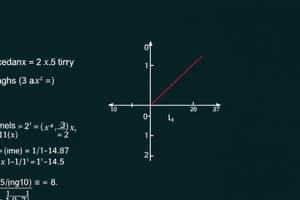Podcast
Questions and Answers
Given an absolute value function $f(x) = a|x - h| + k$, how does changing the value of 'a' affect the graph?
Given an absolute value function $f(x) = a|x - h| + k$, how does changing the value of 'a' affect the graph?
- It vertically stretches or compresses the graph and can reflect it over the x-axis. (correct)
- It shifts the graph vertically.
- It shifts the graph horizontally.
- It reflects the graph over the y-axis.
Consider the absolute value function $f(x) = |x|$. How does the graph of $g(x) = |x + c|$ compare if $c$ is a positive constant?
Consider the absolute value function $f(x) = |x|$. How does the graph of $g(x) = |x + c|$ compare if $c$ is a positive constant?
- The graph shifts 'c' units to the right.
- The graph shifts 'c' units downwards.
- The graph shifts 'c' units upwards.
- The graph shifts 'c' units to the left. (correct)
How does the domain of a quadratic function, represented by $f(x) = ax^2 + bx + c$, differ from the domain of a rational function, such as $g(x) = \frac{1}{x}$?
How does the domain of a quadratic function, represented by $f(x) = ax^2 + bx + c$, differ from the domain of a rational function, such as $g(x) = \frac{1}{x}$?
- Both quadratic and rational functions have the same domain.
- Quadratic functions have a domain of all real numbers, while rational functions may have restrictions where the denominator is zero. (correct)
- Rational functions always have a domain of all real numbers, while quadratic functions may have restrictions.
- Quadratic functions have restricted domains while rational functions do not.
Given the quadratic function $f(x) = a(x - h)^2 + k$, how would you determine the vertex of the parabola?
Given the quadratic function $f(x) = a(x - h)^2 + k$, how would you determine the vertex of the parabola?
What is the impact of a negative leading coefficient on a quadratic function, such as in $f(x) = -ax^2 + bx + c$ where $a > 0$?
What is the impact of a negative leading coefficient on a quadratic function, such as in $f(x) = -ax^2 + bx + c$ where $a > 0$?
How does changing the 'h' value in the vertex form of a quadratic equation, $f(x) = a(x - h)^2 + k$, transform the graph?
How does changing the 'h' value in the vertex form of a quadratic equation, $f(x) = a(x - h)^2 + k$, transform the graph?
If a quadratic function's vertex is at $(2, -3)$ and it opens upwards, which statement is true about its range?
If a quadratic function's vertex is at $(2, -3)$ and it opens upwards, which statement is true about its range?
Consider the inequality $y > |x - a| + b$. How does changing the value of 'b' affect the solution set?
Consider the inequality $y > |x - a| + b$. How does changing the value of 'b' affect the solution set?
Which transformation is applied to the parent function $f(x) = x^2$ to obtain the function $g(x) = (x - 3)^2 + 5$?
Which transformation is applied to the parent function $f(x) = x^2$ to obtain the function $g(x) = (x - 3)^2 + 5$?
If a graph of an absolute value function is vertically compressed by a factor of 2 and reflected over the x-axis, what transformation equation represents this?
If a graph of an absolute value function is vertically compressed by a factor of 2 and reflected over the x-axis, what transformation equation represents this?
Given the function $f(x) = a|x - h| + k$, what effect does changing the value of h have on the graph of the function..?
Given the function $f(x) = a|x - h| + k$, what effect does changing the value of h have on the graph of the function..?
How does the graph of $f(x) = |x|$ differ from the graph of of $g(x) = -|x|$?
How does the graph of $f(x) = |x|$ differ from the graph of of $g(x) = -|x|$?
Compare $f(x) = x^2$ and $f(x) = 3x^2$. What is true of the absolute value of their slopes as x increases?
Compare $f(x) = x^2$ and $f(x) = 3x^2$. What is true of the absolute value of their slopes as x increases?
Which transformations are present in $f(x) = (x+3)^2 - 5$?
Which transformations are present in $f(x) = (x+3)^2 - 5$?
How does the domain of an absolute value function $f(x) = |x|$ differ from the domain of $g(x) = \frac{1}{x}$
How does the domain of an absolute value function $f(x) = |x|$ differ from the domain of $g(x) = \frac{1}{x}$
If the graph of $f(x) = x^2$ is shifted down 3 and to the right 5, what function represents this transformation?
If the graph of $f(x) = x^2$ is shifted down 3 and to the right 5, what function represents this transformation?
The axis of symmetry for a paraobla is $x=3$ and passes through the point $(5,6)$. What is the y coordinate of the vertex?
The axis of symmetry for a paraobla is $x=3$ and passes through the point $(5,6)$. What is the y coordinate of the vertex?
How does adding a constant affect the range of a function?
How does adding a constant affect the range of a function?
A quadratic has a vertex of (3,4) and passes through (2,0). What other x-intercept exists?
A quadratic has a vertex of (3,4) and passes through (2,0). What other x-intercept exists?
What transformations are performed to the parent function $f(x) = |x|$ to obtain $g(x) = -2|x+3|-4$?
What transformations are performed to the parent function $f(x) = |x|$ to obtain $g(x) = -2|x+3|-4$?
Flashcards
What is the vertex?
What is the vertex?
The highest or lowest point on a graph; for absolute value functions, it's where the graph changes direction.
What is the domain?
What is the domain?
Represents all possible input values (x-values) for which the function is defined.
What is the range?
What is the range?
Represents all possible output values (y-values) of a function.
What is Vertical Stretch/Compression?
What is Vertical Stretch/Compression?
Signup and view all the flashcards
What is horizontal shift?
What is horizontal shift?
Signup and view all the flashcards
What is vertical shift?
What is vertical shift?
Signup and view all the flashcards
What is Reflection in x-axis?
What is Reflection in x-axis?
Signup and view all the flashcards
What is Axis of Symmetry?
What is Axis of Symmetry?
Signup and view all the flashcards
What is reflection across the x-axis (quadratics)?
What is reflection across the x-axis (quadratics)?
Signup and view all the flashcards
What is Parent Function?
What is Parent Function?
Signup and view all the flashcards
Study Notes
- Domain and range are fundamental concepts for describing functions
- The domain is the set of all possible input values (x-values) for which a function is defined
- The range is the set of all possible output values (y-values) that the function can produce
Absolute Value Functions
- The absolute value of a number is its distance from zero, always non-negative
- The general form of an absolute value function is f(x) = a|x - h| + k, where (h, k) is the vertex
- The vertex represents the minimum or maximum point of the function
Transformations of Absolute Value Functions
- Vertical Stretch: If |a| > 1, the graph is stretched vertically, making it narrower
- Vertical Compression: If 0 < |a| < 1, the graph is compressed vertically, making it wider
- Reflection: If a < 0, the graph is reflected over the x-axis
- Horizontal Shift: The term (x - h) shifts the graph horizontally
- If h > 0, the graph shifts to the right by h units
- If h < 0, the graph shifts to the left by |h| units
- Vertical Shift: The term k shifts the graph vertically
- If k > 0, the graph shifts upward by k units
- If k < 0, the graph shifts downward by |k| units
- Vertex Form: f(x) = a|x - h| + k
Quadratic Functions
- A quadratic function is a polynomial function of degree 2, generally written as f(x) = ax² + bx + c
- The graph of a quadratic function is a parabola
- The vertex of a parabola is its minimum or maximum point
Axis of Symmetry
- The axis of symmetry is a vertical line that passes through the vertex of the parabola, dividing it into two symmetric halves
- Its equation is x = h, where h is the x-coordinate of the vertex
Vertex Form
- The vertex form of a quadratic function is f(x) = a(x - h)² + k, where (h, k) is the vertex
- From this form, the vertex (h, k) can be easily identified
- Convert between forms by completing the square
Transformations of Quadratic Functions
- Vertical Stretch/Compression: If |a| > 1, the graph is stretched vertically
- If 0 < |a| < 1, the graph is compressed vertically
- Reflection: If a < 0, the graph is reflected over the x-axis
- Horizontal shift: Described by h in f(x) = a(x - h)² + k
- Vertical shift: Described by k in f(x) = a(x - h)² + k
Inequalities
- When graphing inequalities, the area above or below the function is shaded
- Dashed line if the inequality is strict (< or >)
- Solid line if the inequality includes equality (≤ or ≥)
Piecewise Functions
- A piecewise function is defined by different expressions over different intervals of its domain
- Graph each piece separately over the specified interval
- Pay attention to the endpoints of each interval, using open or closed circles to indicate whether the endpoint is included
End Behavior
- End behavior describes what happens to the function values as x approaches positive or negative infinity
- For polynomials, the end behavior is determined by the leading term (term with the highest power of x)
Function Families
- Recognizing function families help in quickly understanding the type of graph
- Examples: Linear, absolute value, quadratic
Parent Functions
- The simplest form of a function family
- Linear: f(x) = x
- Absolute value: f(x) = |x|
- Quadratic: f(x) = x²
Studying That Suits You
Use AI to generate personalized quizzes and flashcards to suit your learning preferences.




